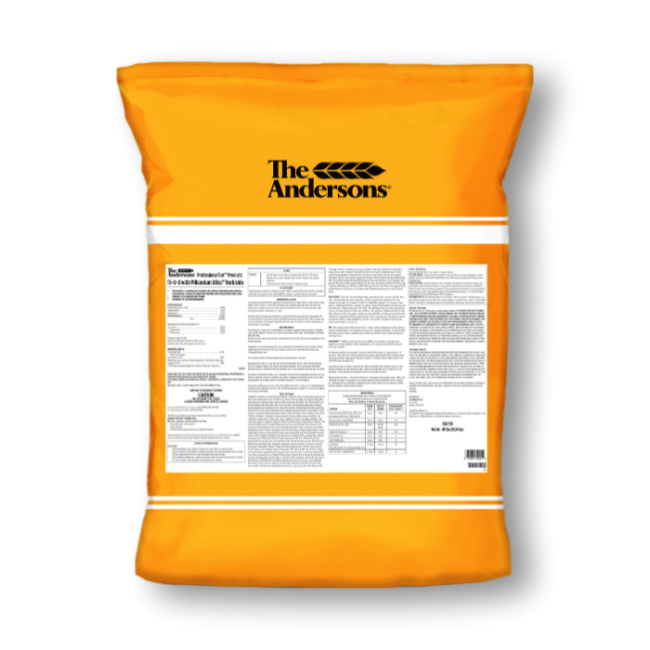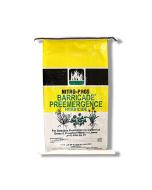Gain access to personalized product screening, the best pricing, rewards, and more!
The Anderson's 15-0-8 with Millennium Ultra Herbicide
The Anderson's 15-0-8 with Millennium Ultra Herbicide is a professional fertilizer and post-emergent weed killer that combines fast-acting post-emergent weed control with extended feeding to deliver a lush, weed-free lawn on golf courses, sports fields, and ornamental turf.
09/21/25
The Anderson's 15-0-8 with Millennium Ultra Herbicide, manufactured by the Andersons, is a quality, premium fertilizer and post-emergent weed control combination that delivers fast-acting herbicide performance and extended feeding for thick, healthy grass while effectively eliminating a wide range of broadleaf weeds.
At its core, this granular fertilizer and herbicide is a dual-action product that delivers balanced nutrition for deep green color and healthy turf growth. The herbicide is formulated to work quickly, so applicators will see weeds start to curl, twist, and fade within days. From dandelions and clover to plantain, chickweed, henbit, thistles, and more than 100 broadleaf species, this product delivers results across the board.
The Anderson's 15-0-8 with Millenium Ultra Herbicide is a dual-purpose granular fertilizer and post-emergent herbicide that achieves a quick nutrient boost in industrial and institutional turf, but the formulation is designed to provide both fast-acting and long-lasting feeding, keeping professionally-managed turf healthy for weeks. By combining nutrition and weed management into one application, it saves applicators time, reduces labor costs, and ensures that the turf looks and performs at its absolute best.
Tools Needed
A rotary spreader, handheld spreader, push spreader, or broadcast spreader is needed.
How to Use
- Step 1: Determine how much The Anderson's 15-0-8 with Millennium Ultra Herbicide to use by measuring the square footage of the treatment area. Find the square footage by measuring the treatment area's length and width in feet, then multiply them together (length X width = square footage). Apply 4 pounds of The Anderson's 15-0-8 with Millenium Ultra Herbicide per 1,000 sq. ft. The 40-pound size of this product should be used to treat 10,000 sq. ft. The maximum number of broadcast applications per treatment site is 2 per year.
- Step 2: Calibrate your spreader to the recommended settings on the label for even coverage. Load the correct amount of granules into the spreader.
- Step 3: Spread the granules evenly across the treatment area and avoid overlapping. Avoid watering for 48 hours after application. If lawns are heavily infested with weeds, a second treatment can be made 30 days after the first application.
Where to Use
The Anderson's 15-0-8 with Millennium Ultra Herbicide can be used on ornamental turf lawns (Industrial and Institutional), parks, cemeteries, athletic and recreational sports fields, golf courses (fairways, aprons, tees and roughs), and similar turf areas.
Not for use on turf grown for sale or other commercial use as sod, or for commercial seed production, or for research purposes.
Do not treat Bentgrass Tees or residential turf.
Do not use on Centipede, Dichondra, and St. Augustine.
Do not use this product where desirable clovers are present or allow the product to “wind drift” onto flowers, vegetables, ornamentals, shrubs, trees or other desirable plants.
When to Use
Best results are obtained when weeds are growing actively in spring or early fall.
Do not reseed for at least 3 to 4 weeks after application. Do not apply to newly seeded or sodded lawn until after 3 mowings.
For optimum results: Avoid mowing 1 to 2 days before and after application; Apply when grass is moist (after a rain, sprinkling or dew); Avoid unnecessary disturbances, including watering of treated areas for 48 hours after application. Watering will wash off weed killing material; and avoid applying if rainfall is expected within 48 hours following treatment.
Do not apply when the air temperature exceeds 90 degrees Fahrenheit.
Safety Information
The Anderson's 15-0-8 with Millenium Ultra Herbicide is safe for people and pets when applied according to the product label instructions. Always wear the proper personal protective equipment (PPE) when handling and applying this product.
Special Considerations
Do not collect grass clippings for mulch or compost. Do not send clippings to a compost facility. Applicator must give notice to landowners/property managers to not use grass clippings for mulching or composting.
| Availability | Online |
| Restricted Use | No |
| Shipping Restrictions | 40 Pound: AK, CA, CT, HI, IN, MI, NY, OR, RI, SC, VT, WA |
| Brand | THE ANDERSONS |
| Keith's Pro Tips | "Aeration is essential for maintaining healthy turf by relieving soil compaction and improving air, water, and nutrient flow to the roots. The best time to aerate cool-season grasses is in early fall or spring, while warm-season grasses benefit most from late spring to early summer aeration." |
| Target Pests | Alder, Annual yellow sweet clover, Artichoke, Aster, Austrian fieldcress, Bedstraw, Beggartick, Biden, Bindweed, Bird vetch, Bitterweed, Bitter wintercress, Black-eyed Susan, Black medic, Black mustard, Black-seed plantain, Blessed thistle, Blue lettuce, Blue vervain, Box elder, Bracted plantain, Brassbuttons, Bristly ox tongue, Broadleaf dock, Broadleaf plantain, Broomweed, Buckhorn, Buckhorn plantain, Bulbous buttercup, Bull nettle, Bull thistle, Burdock, Burning nettle, Bur ragweed, Burweed, Buttercup, Canada thistle, Carolina geranium, Carpetweed, Catchweed bedstraw, Catsear, Catnip, Chickweed, Chicory, Cinquefoil, Clover, Cockle, Cocklebur, Coffee bean, Coffeeweed, Common chickweed, Common mullein, Common sowthistle, Corn Chamomile, Creeping jenny, Crimson clover, Croton, Cudweed, Curry duck, Curly indigo, Dandelion, Dead nettle, Dock, Dogbane, Dogfennel, Elderberry, English daisy, Fall dandelion, False dandelion, False flax, False sunflower, Fiddleneck, Field bindweed, Field pansy, Flea bane (daisy), Flixweed, Florida betony, Florida pusley, Frenchweed, Galinsoga, Garlic mustard, Goathead, Goatsbeard, Goldenrod, Ground ivy, Gumweed, Hairy bittercress, Hairy fleabane, Hawkweed, Healall, Heartleaf drymary, Hedge bindweed, Hedge mustard, Hemp, Henbit, Hoary cress, Hoary plantain, Hoary vervain, Honeysuckle, Hop clover, Horsenettle, Horseradish, Indian mallow, Ironweed, Jewelweed, Jimsonweed, Kochia, Knawel, Knotweed, Lambsquarter, Lespedeza, Locoweed, Lupine, Mallow, Marshelder, Matchweed, Mexicanweed, Milk vetch, Milkweed bloodflower, Mugwort, Morningglory, Mousear chickweed, Musk thistle, Mustard, Narrowleaf plantain, Narrowleaf vetch, Nettle, Orange hawkweed, Oxalis, Oxeye daisy, Parsley-piert, Parsnip, Pearlwort, Pennycress, Pennywort, Peppergrass, Pepperweed, Pigweed, Pineywoods bedstraw, Plains coreopsis, Plantain, Poison hemlock, Poison ivy, Poke oak, Pokeweed, Poorjoe, Povertyweed, Prickly lettuce, Prickly sida, Primrose, Prostrate knotweed, Prostrate pigweed, Prostrate spurge, Prostrate vervain, Puncturevine, Purslane, Ragweed, Red clover, Redroot pigweed, Red sorrel, Redstem filaree, Rough cinquefoil, Rough fleabane, Roundedleaf marigold, Rush, Russian pigweed, Russian thistle, St. Johnswort, Scarlet pimpernel, Scotch thistle, Sheep sorrel, Shepherdspurse, Slender plantain, Smallflower galinsoga, Smartweed, Smooth dock, Smooth pigweed, Sneezewood, Southern wild rose, Sowthistle, Spanishneedle, Spatterdock, Speedwell, Spiny Amaranth, Spiny cocklebur, Spotted catsear, Spotted knapweed, Spotted spurge, Spurge, Spurweed, Stinging nettle, Stinkweed, Stitchwort, Strawberry clover, Sumac, Sunflower, Sweet clover, Tall nettle, Tall vervain, Tansy mustard, Tansy ragwort, Tanweed, Tareweed, Thistle, Tick trefoil, Toadflax, Trailing Crownvetch, Tumble mustard, Tumble pigweed, Tumbling mustard, Velvet leaf, Venice mallow, Veronica, Vervain, Vetch, Virginia buttonweed, Virginia creeper, Virginia pepperweed, Wavyleaf bullthistles, Western amaranths, Western salsify, Western sticktight, White cockle, Wild artemisia, Wild buckwheat, Wild carrot, Wild four-o’clock, Wild garlic, Wild geranium, Wild lettuce, Wild marigold, Wild mustard, Wild onion, Wild parsnip, Wild radish, Wild rape, Wild strawberry, Wild sweet potato, Wild violet, Wild vetch, Wild rose, Willow weed, Wisteria, Wombat plant, Wood sorrel, Wormseed, Wormwood, Yarrow, Yellow rocket, and Yellowflower pepperweed. |
| Application Equipment | Push Spreader, Rotary Spreader |
| Application Methods | Granular Spreading |
| Active Ingredient | Nitrogen 15.00% Soluble Potash 8.00% Chlorine 6.78% 2,4-D 0.690% Clopyralid Acid 0.071% Dicamba Acid 0.071% |
| Product Type | Herbicide |
| Formulation | Granular |
| Application Rate | Apply 4 pounds of The Anderson's 15-0-8 with Millenium Ultra Herbicide per 1,000 sq. ft. The 40-pound size of this product should be used to treat 10,000 sq. ft. The maximum number of broadcast applications per treatment site is 2 per year. |
| Yield | 40 pounds of The Anderson's 15-0-8 with Millennium Ultra Herbicide will cover 10,000 sq. ft. |
| Use Sites | Outdoors |
| Comparable Products | Solutions 15-5-10 Weed & Feed Fertilizer with Trimec |
| Use Caution With | St Augustine |
| EPA Registration # | 228-343-9198 |
| Restricted Use | No |
|---|---|
| Shipping Restrictions | AK, CA, CT, HI, IN, MI, NY, OR, RI, SC, VT, WA |
| Availability | Online |
| Signal Word | CAUTION |
| Keith's Pro Tip | "Aeration is essential for maintaining healthy turf by relieving soil compaction and improving air, water, and nutrient flow to the roots. The best time to aerate cool-season grasses is in early fall or spring, while warm-season grasses benefit most from late spring to early summer aeration." |
| Chemical Type | Herbicide |
| Formulation | Granular |
| Application Methods | Granular Spreading |
| Active Ingredient | Nitrogen 15.00% Soluble Potash 8.00% Chlorine 6.78% 2,4-D 0.690% Clopyralid Acid 0.071% Dicamba Acid 0.071% |
| Application Equipment | Push Spreader, Rotary Spreader |
| Mix Rate | Apply 4 pounds of The Anderson's 15-0-8 with Millenium Ultra Herbicide per 1,000 sq. ft. The 40-pound size of this product should be used to treat 10,000 sq. ft. The maximum number of broadcast applications per treatment site is 2 per year. |
| Use Sites | Outdoors |
| Yield | 40 pounds of The Anderson's 15-0-8 with Millennium Ultra Herbicide will cover 10,000 sq. ft. |
| EPA Registration No. | 228-343-9198 |
| Comparable Products | Solutions 15-5-10 Weed & Feed Fertilizer with Trimec |
| Children or pets? | No |
| Property Characteristics | None |
*Price does not include freight. We guarantee our rate plus shipping will be less than anyone else's price.














